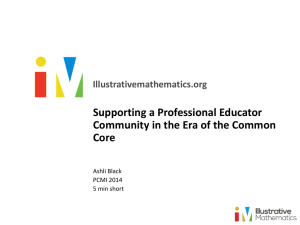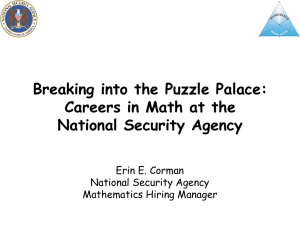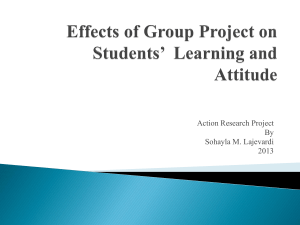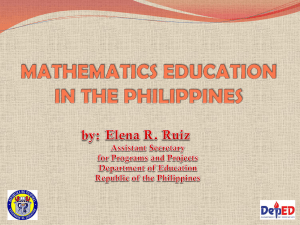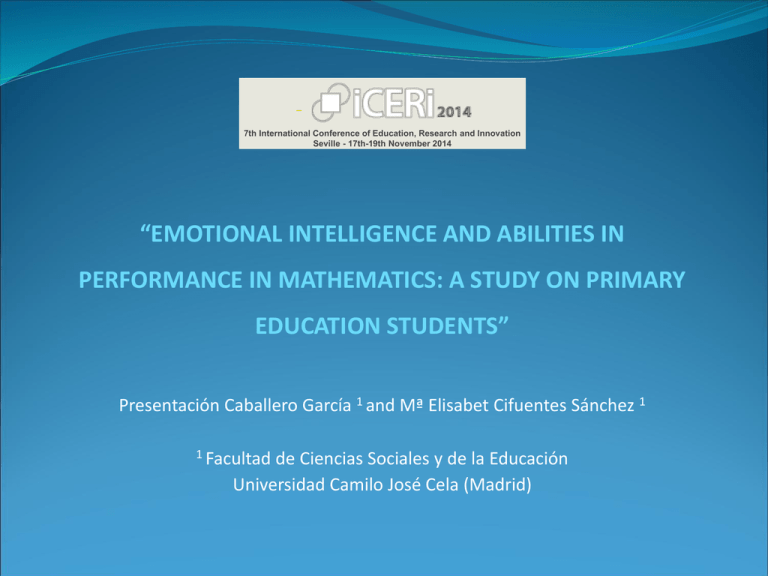
7th International Conference of Education, Research and Innovation
Seville - 17th-19th November 2014
“EMOTIONAL INTELLIGENCE AND ABILITIES IN
PERFORMANCE IN MATHEMATICS: A STUDY ON PRIMARY
EDUCATION STUDENTS”
Presentación Caballero García 1 and Mª Elisabet Cifuentes Sánchez 1
1 Facultad
de Ciencias Sociales y de la Educación
Universidad Camilo José Cela (Madrid)
INTRODUCTION
Inappropiate emotional education at school.
Low
marks
evaluation)
in
mathematics
(international
Emotional education, aptitud and performance in
mathematics in primary students.
Affective and aptitudinal factors in the process of
learning mathematics.
OBJECTIVE
Prove the relationship that may exist between emotional
intelligence, abilities and performance in mathematics.
HYPHOTESIS
Hi1: There is a positive relationship between emotional
intelligence, abilities and performance in mathematics.
Hi2: Emotional intelligence and abilities of students are
predictors of performance in Mathematics.
METHODOLOGY
Descriptive
Cuantitative Approach
Predictional
Mixed
Design
(Bisquerra,
2005)
Explicative
Correlational
METHODOLOGY
Participants
34 students (21 boys and 13 girls) of a group of 6th year of primary
school, with average age of 11,5 years.
Percentage
80
60
61.76
40
38.24
20
0
BOYS
GIRLS
Sex
Instruments
TMMS-24 (Fernández-Berrocal, Extremera y Ramos, 2004).
BADyG-E3 (Carlos Yuste, Martínez Arias y Gálve, 2009).
Lists of results in mathematics
METHODOLOGY
Procedimiento de recogida de datos
Data collection procedures
Apply for permissions
Choose sessions for application
Development of sessions: 1 hour of duration approximately
1st session: BADyG-E3 I (4 testing)
2nd session: BADyG-E3 II (5 testing)
3rd session: test TMMS-24
4th session: Collecting lists of results in mathematics
Tabulation and data analysis.
METHODOLOGY
Data analysis
Descriptive analysis: frecuencies, percentages, aferages
and standard deviations.
Bivariate Pearson correlation.
T Student test and simple analysis of variance (ANOVA).
Multiple Regressions Analysis.
SPSS 19, with a confidence of 95% and an error level of 5%.
RESULTS
To Know the level of Emotional Intelligence of a group of students of 6th year of
primary education of CEIP. Cervantes.
The general average level of EI is appropiate (
90
80
70
60
50
40
30
20
10
0
82.32
=82,32, =16,01).
EI TOTAL
Avareness of Emotional
Experience
27.37
27.99
Emphaty
26.96
Emotional selfmanagement
RESULTS
To evaluate differencial and general aptitudes of a group of students of 6th
year of primary education of CEIP. Cervantes.
Evaluated students have an average general level
32
28
24
20
16
12
8
4
0
23.5
17.41 17.26
( =17,85).
24.03
19.94
14.97
12.26
14.47
15.88
Average
RESULTS
To know the performance in mathematics of a group of students of 6th year of
primary education of CEIP. Cervantes.
Results are also good, with an average mark of B ( =7,03,
N
Performance in
Mathematics
34
Minimum
Maximum
4,80
9,50
=1,59).
Standard
Average
Desv.
7,0274
1,59105
RESULTS
To analyze the relationship that may exist between emotional intelligence and
performance in mathematics of students.
Pearson Correlation
not exist any lineal positive relationship
between total emotional intelligence and students’ performance in
mathematics (rP=0,102; p=0,566).
To analyze the relationship that may exist between general abilities and
performance in mathematics of students.
Not exist any relationship between general abilities and performance in
mathematics, but there is a relationship between certain differencial
abilities:
- Verbal Analogies (rP=0,453(**), p=0,007)
-
-
Numerical Sequences (rP=0,565(**), p=0,000)
Number Problems (rP=0,460(**), p=0,006)
Visual Memory (rP=0,567(**), p=0,000)
Spotting the differences (rP=0,449(**), p=0,008).
RESULTS
To analyze if emotional intelligence of students suppose differences in
aptitudes and performance in mathematics.
EI do not make any difference either in general abilities or in the students´
performance in mathematics. However, it do indicte significant differences
in relation to some differencial abilities.
-
Avareness of emotional experience
there are significant differences
in Completing Sentences. Students with low levels of awareness obtained
a higher average in completing sentences (F=4,321, p=0,02; Tukey=5,9*,
p=0,019).
-
Emotional self-management
there are significant differences:
Students with better emotional self-management obtained a higher
average in Verbal Analogies (F=9,907, p=0,00) and Completing
Sentences (F=5,41, p=0,01; ukey=5,57*, p=0,048).
RESULTS
To analyze if aptitudes suppose differences in emotional intelligence and
performance in mathematics.
General abilities do not make any difference either in EI and general
performance in mathematics, but they make it differencial abilities in:
a) EI:
-
Visual memory – Total EI: Students with below average marks in visual
memory are those who have more emotional intelligence; nevertheless,
students with above average marks in visual memory have obtained the
lowest average in emotional intelligence (F=3,353, p=0,023).
-
Visual memory– Avareness of emotional experience: Students with an
above average level of visual memory are those who have the lowest
level of awareness of emotional experience F=3,200, p=0,027).
-
Verbal analogies – Emotional self-management: Students who have
obtained higher results in the verbal analogies ability are those with the
lowest average of emotional self-management(F=2,867, p=0,041).
(Tukey=14,5*, p=0,027).
RESULTS
To analyze if aptitudes suppose differences in emotional intelligence and
performance in mathematics.
General abilities do not make any difference either in EI and general
performance in mathematics, but they make it differencial abilities in:
b) Performance in Mathematics :
-
Number Problems (F=4,420, p=0,003).
higher results
the highest marks in mathematics.
-
Numerical Sequences (F=3,789, p=0,007).
higher results
the highest marks in mathematics.
-
Memory for Oral storytelling (F=3,097, p=0,031).
extremely high or low results
the lowest marks in mathematics
RESULTS
To know the value that EI and abilities may have in order to predict
performance in mathematics.
Multiple Regressions Analysis
56,1% of changes in performance in
mathematicas are due to these variables.
Exist a significant relationship in:
-
Higher empathy is related to higher performance in Mathematics(B=
0,111; t=2,143; p=0,044).
-
Higher marks in verbal analogies are related to higher performance in
mathematics (B=0,142; t=2,238; p=0,036).
-
Better visual memory is also related to higher performance in
mathematics (B= 0,097; t=2,221; p=0,037).
The most significant variable is “verbal analogies”, followed by “visual
memory” and “empathy”.
DISCUSSION
In accordance with findings by other authors such as Durén,
Extremera, Rey, Fernández-Berrocal y Montealban (2006); Ferrando,
Prieto, et al. (2010); Nasir y Masrur (2010); y Palomera, Gil-Olarte y
Brackett, (2006), this study has proved the relationship between
emotional intelligence, abilities and performance in mathematics and
the predictive capacity that some dimensions of these variables have
in this type of performance.
The abilities with higher capacity to predict
performance in
mathematics are verbal analogies and visual memory. This results are
similar to those obtained by Laidra, Pullman, y Allik, 2007; Rolfus y
Ackerman, 1999).
Also the variable of empathy can predict performance in
mathematics (Callejo, 2004; Frank 1988; Gairín, 1990; Garofalo, 1989;
Gómez-Chacón, 1997; McLeod, 1992; Schoenfeld, 1985, 1992).
LIMITATIONS AND PROSPECTIVE
It is necessary studies, with larger and more representatives
samples that allow us to confirm more precisely the relationship
between Emotional Intelligence and aptitudes in performance
in Mathematics.
Continue to investigate in this line and explain in a more
extensive our primary students´ results in mathematics, from
the study of differents components of the affective domain as
beliefs, attitudes, and emotions; or other variables such as
evaluative anxiety, self-esteem, attributional style, previous
learning experiences, etc.
More studies are necessary to improve the students’ results in
this subject and to help to prevent academic failure.
“THANK YOU FOR YOUR
ATTENTION”


